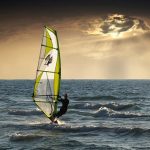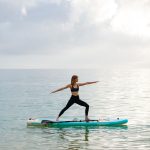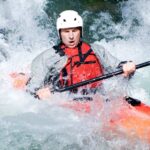Windsurfing is a great water sport that, although not the most popular, can be easily learned with the right equipment. Here, we provide guidance on choosing the best gear for beginners to make learning windsurfing as easy as possible.
Essential Equipment
If you want to learn an extreme sport, you need to understand all the essential equipment. Fortunately, there are only three pieces of equipment needed for the sport. Everything else is an accessory, required for safety or convenience.
To sail through the water’s surface, the surfer needs the following three items:
- windsurf board
- rig system
- roof rack
Many beginners make the mistake of thinking they need to buy the most expensive gear in order to learn a sport. However, this is often not the case. With that said, let’s look at the right equipment for your skill level.
Windsurf Board
The importance of a windsurfer’s board cannot be overstated. You want to make sure that your first purchase will give you the most value for your money. To make a wise investment, it is helpful to first understand all the different parts of the board. Let’s take a closer look.
Choosing the Right Board Size
Therefore, a board that is 200 liters in volume will support approximately 200 kilos. The most important thing to consider when choosing a windsurfing board is the size, which is determined by the volume.
The volume is the amount of space inside the board and is directly related to the amount of weight it can support. Generally, 1 liter of volume will support 1 kilo of weight.
Therefore, a board that is 200 liters in volume will support approximately 200 kilos.
Adding 50 to 80 liters to a board’s volume creates more stability for performance, which is why experts recommend it.
A surfer who weighs 75 kilograms should surf on a board with 125-155 liters of volume. The same principle can be applied to the width of the board.
Beginners should focus on a board with a wider base, which will increase stability when sailing with lighter winds and near the shore.
Choosing the Right Fin
The fin is a very important part of choosing your first board, as it determines many aspects of riding, such as direction, maneuverability, and jumping.
A smaller fin is better for making quick turns and sailing in strong winds, while a larger fin is better for high-speed performance in weaker winds.
A beginner should choose a board with a smaller fin, as it is easier to move around and will build confidence in their sailing ability.
Rig
The board is not important, you will need a good quality rig, which consists of a sail, mast and boom.
The sail uses the wind to move the boat forward and make it go faster. The mast is the tall pole that the sail is attached to. It provides support for the sail.
The boom is the horizontal pole that is attached to the mast. It allows the person sailing to control the sail.
If you take away the rig components, you’re left with nothing more than a surfboard.
What to Look For in a High-Quality Rig System
When buying a rigged system, most people buy a bundled deal which includes the sail, mast and boom, to guarantee that they all match. However, there are some factors to consider when examining each component as a whole.
As a beginner, you should purchase a 5-6m sail. This size sail can handle light wind forces and is ideal for practicing in calmer conditions. Once you are more comfortable sailing in stronger winds, you can purchase a smaller sail.
This will give you more control in harsher winds.
If you have a 5-6 meter sail, you should also have a skinny mast so it’s easier to handle.
Carbon is also sturdy and lightweight, but it will give you a lot more forgiveness on those big days when you make a mistake There are two choices for the boom: aluminum or carbon.
Aluminum is sturdy and lightweight and will work well with the rig described above. Carbon is also sturdy and lightweight, but it will be more forgiving on days when you make a mistake.
Roof Rack
For anyone who enjoys activities that require a board, such as surfing, snowboarding, or skateboarding, you understand the hassle of loading your gear back and forth in your car.
Previously, boarders would haphazardly play a game of Tetris by attempting to fit all their gear inside their car.
This led to many issues during their travels, such as limiting the number of people you can bring along and covering up some of your blind spots, which then restricts how you drive.
Advantages of Using a Roof Rack
I recommend getting a roof rack to transport equipment because it has many benefits. It makes you feel safer on the road because you can see 360 degrees around your car.
You won’t have to worry about guessing when changing lanes because you won’t have any blind spots.
The second advantage of carrying your gear on the roof is that you can fit more of it in the car. With the big items (surfboard and sail) safely secured on the roof, you’ll have more room in the car to pack all the other things you need.
You might even be able to carpool with friends, as long as they have their gear to put on the rack too. The rack system makes it easy to stack multiple boards on top of each other.
And even with all that gear on the roof, you’ll still have plenty of space in the trunk for anything else you need to bring.
Disadvantages of Using a Roof Rack
I can only issue one complaint against roof racks and that is they decrease your car’s gas mileage. Cars are built to be aerodynamic to achieve fuel economy and adding a roof rack creates drag to the car, making it use more fuel.
If you have an empty roof rack, your gas mileage will drop by 7 percent. However, if you add bulky gear, the mileage will drop by close to 20 percent.
Even though this causes your mileage to drop, it is still a necessary tool to safely carry your equipment back and forth.
Accessory Equipment
Foot Straps
Foot straps are not necessary for beginners, and you won’t know what to do with them until you learn to use a harness and start planning. If your beginner board doesn’t have foot straps, don’t worry.
Windsurfing Sail
When choosing a windsurf sail, the only things you need to consider are its size and whether or not it has cams. Look for sails labeled as “freeride” or “wave” sails.
Sail size
Windsurf sails are measured in meters square. You will want a sail in the 4 to 5-meter size range if you are a beginner. A larger sail will be more difficult to balance and uphaul, as well as being more difficult to rig and transport.
Do not give in to temptation and buy a large sail just because you saw a good deal on a used sail rig; these sails are much more difficult to uphaul.
Start with a smaller sail and you can keep it as your stronger wind sail for later use.
Mast & Boom
The size of your sail is determined by the luff length and boom length, which can be found on the sail or in the sail bag.
To make things simpler for beginners, it is best to buy a rig package that contains the sail, mast, and boom together. This will make sure that all the parts work together.
The length and carbon content of masts are labeled on them. A 460cm 30% mast is 460cm long with 30% carbon.
As a beginner, you don’t need any carbon in your mast, which would just make it more expensive. A 0% carbon epoxy mast will work well for you in the learning stages.
When you get better and want a bigger sail, you’ll need a bigger mast. At that point, invest in a 30% or higher carbon mast.
If you want a boom, all you really need to pay attention to is getting one that has a good range and is the right size for your sail.
An aluminum boom will work just as well as a carbon fiber one, and last you much longer. Many experienced windsurfers still use aluminum booms.
Mast Extension, Mast Base and Uphaul
The first piece you need to rig the sail is the mast extension, which makes up the difference in luff length between the sail and the mast.
To use the mast, you must attach it to the board using the mast base or mast foot. The mast base is a fitting that goes into the mast track on the board and fits into the bottom of the mast extension.
There are two versions of this—EuroPin and US Base. US Base is the most common in the United States. The easiest and best mast base system to get is the 2 bolt Tenden base by Chinook.
This has a mast base plate that stays with the board. It has a flex fitting that goes into the mast base. The flex fitting attaches to the base plate with a nice, slick quick release slide.
You need to slide a fitting into the mast track and twist it to tighten it every time you use the rig.
The last thing you need is an uphaul. This is a piece of webbing with a bungee inside that you use to pull the sail out of the water. It attaches to the front end of your boom, and you loop it around your mast base before attaching it to the board.
A Life Jacket or Buoyancy Aid
A beginner will fall off the windsurfer frequently. Eventually, you will getgood enough to not need a harness. A life jacket is a good idea because you will be falling a lot and landing in the water in strange positions.
Inflatable life jackets are not recommended. If it’s an auto-inflater, it will inflate within your first 5 minutes on the board when you fall in. If it’s a manual-inflating vest or a belt pack, it won’t do you any good.
If you fall and somehow weirdly hit your head and knock yourself out, you won’t be able to pull the inflate cord.
Wetsuit
If you’re planning on spending time in colder water or air, it’s a good idea to invest in a wetsuit. They can help keep you warm while you’re in the water and protect you from the cold when you get out.
Is Used Gear Any Good?
There are many old sails available, especially from the 1980s. While these may be okay, you may find that the mast base isn’t compatible with a modern board. In addition, the mast and boom likely aren’t compatible with modern equipment, making it difficult to find replacement parts.
Booms and masts used for windsurfing haven’t seen many changes since the 1990s. I got my first windsurfer in 1998, and the 460cm PowerX 30% Carbon mast was the same as what you would find on a current 460cm mast.
The same goes for the Chinook boom, extension, and mast base. The construction of the sails were also similar, although the tops were less square. Sails and rig parts from the mid-1990s onwards are still usable if they’re in good condition.



